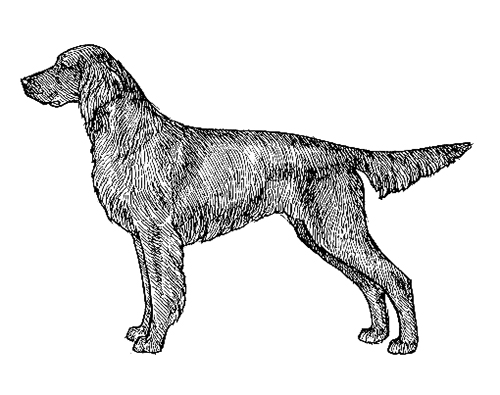German Long Haired Pointer
Gun Dog Group
The goals and purposes of this breed standard include: to furnish guidelines for breeders who wish to maintain the quality of their breed and to improve it; to advance this breed to a state of similarity throughout the world; and to act as a guide for judges.
Breeders and judges have the responsibility to avoid any conditions or exaggerations that are detrimental to the health, welfare, essence and soundness of this breed, and must take the responsibility to see that these are not perpetuated.
Any departure from the following should be considered a fault, and the seriousness with which the fault should be regarded should be in exact proportion to its degree and its effect upon the health and welfare of the dog and on the dog’s ability to perform its traditional work.
History
The German Long Haired Pointer is descended from a combination of bird and water dogs as well as scenthounds, making it a very versatile breed. Pure breeding has been carried out since 1879.
The German Long Haired Pointer was recognized by the United Kennel Club in 2006.
General Appearance
Strong and muscular, with flowing lines. Small dogs must have plenty of substance, but overly massive or clumsy dogs are not desirable.
Characteristics
Good natured and easily trained, with a calm nature.
Head
The beautiful Long Haired head is of special value. It is long and has a noble appearance.
SKULL
The skull and muzzle are of equal length. The skull is slightly rounded, and the stop is gently rising, not deep or sharp.
MUZZLE
Not too slender, with a slightly arched bridge. The lips overlap slightly.
TEETH
The German Long Haired Pointer has a complete set of evenly spaced, white teeth meeting in a scissors bite.
NOSE
Brown, with slightly lighter spots permitted.
EYES
As dark brown as possible, with close fitting lids.
Fault: Yellow eyes.
Disqualifications: Entropion or ectropion.
EARS
Not set on too low, turned slightly forward.
Neck
Clean and fairly long, tapering gradually in width towards the head.
Forequarters
The shoulders are close fitting. The shoulder blade and upper arm form an apparent right angle.
FORELEGS
Seen from the front, the legs are perfectly straight down to the foot. The elbow is close fitting, and the pastern is slightly sloping.
Body
The chest is broad and deep, with well developed forechest. The back is straight and firm, not too long.
The topline slopes gently from withers to croup. The loin is especially muscular and the croup is long and sloping.
Hindquarters
Seen from behind, the bones of the hip, upper and lower thigh and foot should form a vertical line.
HIND LEGS
There should be good angulation at the hock joint. Dewclaws should be removed.
Feet
Oval, with tight toes and coarse pads.
Tail
The tail should be carried horizontally, with the last third turned up.
Faults: Curled or hooked tail.
Coat
On the back and sides of the body, the hair is shorter and close fitting, dense with good undercoat. On the underside of the neck, on the chest and on the belly, it is longer. The ears, tail and back of the legs are nicely feathered. On the head, the hair is short and smooth.
Fault: Curly coat.
Color
Solid colored brown, or brown and white in many combinations, roaned, patched, mottled or speckled. Occasionally, fawn markings occur as a throwback to the hounds.
Height And Weight
Ideal height at the withers for males is 25-26 inches. For females, it is 23½ to 24½ inches. The average weight is approximately 65 pounds.
Gait
Ground covering, with strong drive.
Disqualifications
Unilateral or bilateral cryptorchid. Viciousness or extreme shyness. Albinism. Entropion or ectropion.

Looking for a Dog?
Find a dog that will fit your family.
Note: The breeders on this list are not endorsed by UKC.
©Copyright 2006, United Kennel Club
